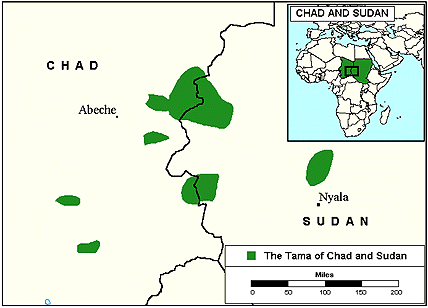"Tama" is a collective term used to describe a cluster of languages and ethnic groups that straddle the borders of Chad and Sudan. They speak dialects of the Tama language. The Tama-speaking peoples include into several subgroups: the Abu Sharib, the Kibet, the Mararit, the Kimr, the Sungor, the Erenga, and the Tama.
Today, the Tama peoples are citizens of the independent nations of Chad and Sudan. They all inhabit sandy, hilly regions with similar climates, grow the same crops, make their homes in the same manner, and have similar lifestyles.
Most of the Sungor, the Abu Sharib and the Mararit are settled shepherds. They plant only small-scale gardens. Since the Sungor own the most livestock, they have the most manure fertilizer, which gives them a better crop yield. Their principal crops include millet, sorghum, sesame, peanuts, okra, onions, chilies, watermelons, and various other vegetables.
Because of the sandy, hilly topography and the shortage of rainwater and ground moisture in Sudan, the only agriculture possible for those groups is dry land farming. Their livestock includes camels, cattle, goats, and sheep. These provide milk and other dairy products, along with wool and leather. These tribes also hunt guinea, fowl and gazelles for meat. One of their main dishes is millet served with various sauces, especially goat meat, okra, and onions.
Sungor women gather products from the forests regularly, particularly during the rainy season. The products include wild grasses, berries, and honey, along with useful tool-making or building materials. Women also help work in the field, engage in basketry, pottery, and other crafts. Women also brew beer from millet, for consumption, for selling or trading. The men do most of the field work and trade at the local markets. They may also work as craftsmen or merchants.
Because of the poor natural resources and economic conditions of the region, some of the Tama migrate from their home territories, searching for work elsewhere, usually in the Nile Valley. Some modern occupations include jobs as clerks, teachers, tailors, drivers, automobile mechanics, and middlemen in trade.
The Sungor live in village compounds. Their houses are round, with diameters of 15-20 feet. They make the walls out of coarse reed mats. They use thatched reeds for their cone-shaped roofs. Some homes, however, have lower, more narrow entrances to keep out the lions and hyenas that roam throughout the region. There is a chief for each village settlement. The chief gives advice to the villagers, handles disputes and makes important decisions. Each village chief answers to a territorial chief, who answers to a higher government official.
Modern schools are not available in most Tama regions. Their only education comes from Islamic schools attended by boys. Therefore, only a small percentage are literate. Some elite families send their children to schools in France, Britain, or other countries. These highly educated Tama hold administrative positions in society.
All the Tama tribes are Muslim, including the Sungor. They adhere to Islamic teachings and hold the traditional Muslim ceremonies and festivals. Most of them also mix animism (belief that non-living objects have spirits) and witchcraft with their Islamic practices.
Only an outpouring of the Holy Spirit and a demonstration of Christ's love for the Sungor people will change their perspective. With Christians living among them to learn their ways, meet some of their needs, and give them a new outlook on life, the lives of the Sungor could be transformed. Someone needs to make such a commitment to this unreached people group.
Pray for Sungor believers to have hearts that are ready and willing to take the name of Jesus to Muslims throughout their region.
Pray for the Sungor people to have hearts that are open to the abundant blessings of Jesus Christ.
Pray for their families to prosper financially and spiritually as they experience a relationship with Jesus Christ.
Pray for a movement to Christ among the Sungor that will spread joy, peace, and salvation to other peoples in East Africa.
Scripture Prayers for the Sungor in Sudan.
| Profile Source: Joshua Project |











